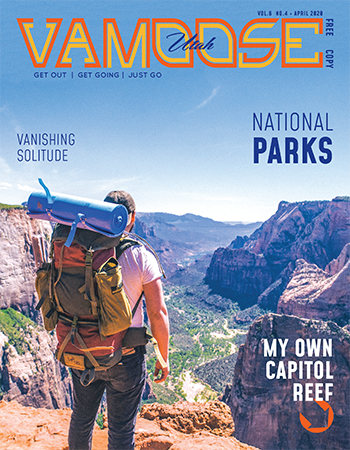A winter’s sojourn to the ancient towers of Hovenweep reward with scenery and solitude.
About 700 years ago, ancestors of the Hopi and Zuni and other Puebloan groups of southeastern Utah and southwestern Colorado abandoned their high-desert homeland and began a great migration south.
Archaeologists debate long and hard as to why they left. Populations had expanded throughout the AD 1000s and 1100s, and by the following century, the population might have exceeded the limited carrying capacity of the desert environment where water was always in limited supply.
It might have been that centuries of deforestation and nutrient depletion of the shallow sandy soils had profound effects on soil quality and the ability of the ancients to raise enough food—corn, beans and squash—to feed the ever-larger populations.
It might also have been that climatic changes resulted in more frequent crop failures, which in turn resulted in increased violence between those with food and those without. Or maybe it was a great, two-decade-long drought that brought to an abrupt end to what had previously been a 1,000-year relationship between the ancient farmers and these high mesas.
Ghostly reminders of the abandonment are common just about anywhere you look in this country, and certainly one of the best visual examples anywhere is Hovenweep National Monument on the Utah-Colorado border. Here, stone towers still stand as silent guardians and ceremonial structures seem to beckon the return of the ancient ones with their songs and dances.
That these ruins are standing some 700 years later is inspiring in a jaw-dropping sort of way. And when you personally experience these architectural masterpieces, you can’t help but wonder what, if anything, we might leave behind that would similarly stand the test of time.
Chances are you’ve never heard of Hovenweep, said to be a Ute word for abandoned valley, or maybe you have heard of it but never ventured there for whatever reason (my own misguided reasons for initially avoiding it seem silly in hindsight, that because it was a national “park,” then it must be swarming with tourists, which is laughably untrue).

Hovenweep is certainly a crown jewel in the National Park Service system, yet it remains largely unknown to the public. It is just far enough off the main highway as to be avoided by the gaggle of tourists racing between Monument Valley and Mesa Verde, and the primitive network of slightly paved and unpaved roads linking the spectacular ruins by and large seems to detour most buses and motor homes. (People who venture into this country are more into car camping and day hiking).
There are exceptional opportunities for quiet and solitude even among the busiest season. But my favorite time to visit is the “off” season from mid-October to mid-April, when the number of visitors dwindles to a mere trickle—it is not uncommon to wander among the ruins and never encounter another soul.
And unlike the other heritage parks, each of the seven “units” or protected parcels that comprise Hovenweep—two in Colorado and five in Utah—affords hiking opportunities where the ancient past can be experienced up close and personal without those annoying barriers and fences and concrete trails that seem to define places like Mesa Verde.
 You can hike and explore for hours, or you can simply ponder without interruption the many mysteries of the past that defy easy explanations.
You can hike and explore for hours, or you can simply ponder without interruption the many mysteries of the past that defy easy explanations.
There are no fees to visit any of the seven clusters of ruins at Hovenweep and camping is reasonable ($10 for a tent space with a fire pit and awning for shade), although camping is limited to one area of the park next to the visitors center. Primitive camping is not allowed.
Visiting in the off season has its rewards (greater quiet and the occasional snowstorm that makes for stunning photographs), but it also has a down side. It can get cold here, often with temperatures barely nudging above freezing.
A lot of off-season visitors prefer to base out of motels in nearby Blanding or Bluff (the drive to the ruins is about an hour or so depending on road conditions). If day tripping is your bag, then you might consider overnighting in Cortez, Colo., where the dining and beverage options are much, much greater, although Cortez adds another hour or so to your return trip to the Wasatch Front.
 The roads to the park visitor center are paved and access is generally quite good. But access to the individual clusters of ruins varies greatly depending on weather conditions (See NPS.gov/hove/planyourvisit/directions.htm). Some of these roads are well maintained and passable to just about any vehicle, and yet others require high-clearance vehicles. It is always a good idea to check in with the rangers at the visitor center for the latest road conditions (970-562-4282 ext.10).
The roads to the park visitor center are paved and access is generally quite good. But access to the individual clusters of ruins varies greatly depending on weather conditions (See NPS.gov/hove/planyourvisit/directions.htm). Some of these roads are well maintained and passable to just about any vehicle, and yet others require high-clearance vehicles. It is always a good idea to check in with the rangers at the visitor center for the latest road conditions (970-562-4282 ext.10).
And remember to always respect the past. Do not stand on or lean on the ruin walls, never pocket any artifact no matter how seemingly insignificant it might be, never touch or trace rock art, and stay on existing trails.
Jerry D. Spangler is a professional archaeologist and executive director of the non-profit Colorado Plateau Archaeological Alliance, which is dedicated to the preservation of ancient sites through public education and outreach.



